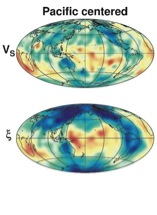My research in seismology focuses on using waves propagating from earthquakes to constrain seismic structure in order to understand processes in deep planetary interiors. Advancing this work requires theoretical seismology, while interpreting the models requires integration of geochemical studies, laboratory mineral physics, and geophysical flow modeling.
My publication and funding record reflects three major areas of research. 1) I generate new models of Earth structure on both global and regional scales in order to understand dynamic processes by analyzing large datasets of seismic observations. 2) I develop new theoretical tools to improve our ability to illuminate deep Earth structure. 3) I extend techniques to handle the challenges of interpreting future data from planetary bodies beyond Earth.
New Models
I develop widely used and cited global-scale tomographic models of the seismic
structure of the Earth's mantle, the rocky layer of the Earth below the crust
which makes up ~85% of the Earth's volume
(e.g. Panning
and Romanowicz, 2006;
Panning et al., 2010;
Tomography page). Seismic tomography is a
technique analogous to medical imaging using waves from earthquakes recorded
at seismic stations around the globe in order to map 3D structure of the
Earth. Advances in this field since its inception have permitted images of
increasing resolution, and the addition of more detail through the imaging of
anisotropy of seismic waves (the focus of much of my research). Anisotropy is
the directional dependence of seismic velocities, and it is direct evidence of
dynamic processes in the Earth. This research has led to high-impact
conclusions about dynamics in the top
(Gung et al., 2003) and
bottom of the
mantle (Panning and
Romanowicz, 2004). Recently, I've focused on regional
scales, applying theoretical approaches I've developed to model southeast Asia
(Panning et al.,
2012), and using a different kind of data called splitting
intensity recorded on dense North American instrumentation
(Hongsresawat et al., 2015).
Theoretical Tools
My research program also focuses on creating new theoretical tools to model
seismic data. I have developed 3D sensitivity kernels for anisotropic
structure that can be more directly compared with flow modeling results
(Panning and
Nolet, 2008), tools to correct the use of popular 3D sensitivity kernels
for seismic waveforms
(Panning et al.,
2009), and an efficient approach to correcting for the effects of the
complicated crust of the Earth when trying to image deeper structure
(Lekic et al.,
2010). On local scales, I have also been working on a new approach to
exploit background noise to determine crustal structure in more detail
(Panning et al., in preparation, 2015), which has illuminated diffuse energy
repeatedly scattering from prominent geologic features in Idaho and Oregon.
Planetary Seismology
The final major topic of my research is applying seismic techniques to other
planetary bodies. I have developed numerical models for likely seismic
signals on Europa, a moon of Jupiter with a global liquid ocean beneath an icy
surface. This work
(Cammarano et al., 2006;
Panning et al., 2006;
web page)
demonstrated that surface waves could be used to determine the thickness of
the ice shell (a primary goal for any study of Europa) with measurements from
a single site. I was also invited to be a co-Investigator for the NASA
InSight mission, scheduled to launch
in March, 2016. This ~$450 million mission will land a geophysical instrument
package on Mars, including seismometers and several other instruments. This
will, for the first time, give us data to tightly constrain the interior
structure and evolution of another planet in our solar system. In advance of
the landing in 2016, we are preparing for the challenges of determining
structure from a single seismic station, as compared to the extensive networks
available on Earth (Panning
et al., 2015).
Future Directions
In the near future, I intend to continue work along all 3 avenues of research.
I am working to produce a high-resolution anisotropic model of North America
using the splitting intensity dataset combined with other seismic data, which
will likely be widely used by researchers with interest in North American
tectonics. I will also focus on further developing the noise scattering
technique and applying it to new areas where dense datasets are available.
Finally, with the landing of the InSight mission imminent, much of my work in
the near future will be focused on taking advantage of this historic dataset.
High impact studies describing the detailed interior of another planet in our
solar system for the first time are likely outcomes.
